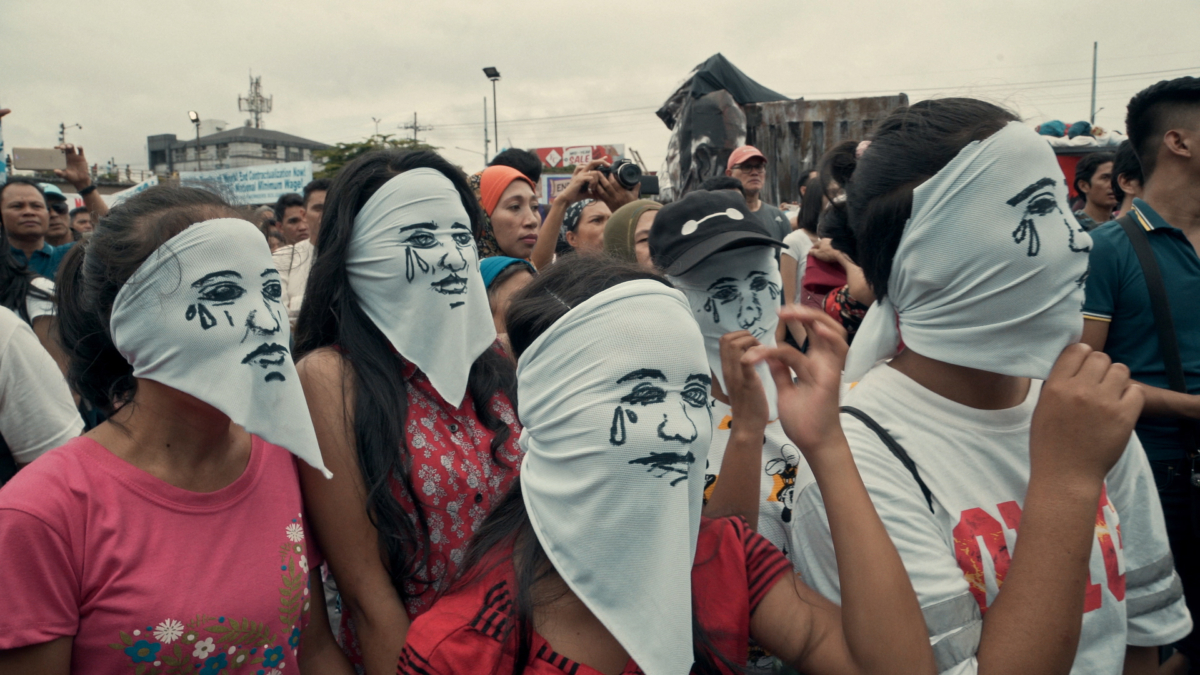Written By: Michelle Ahn
According to Amnesty International, an average of 34 people died a day in the Philippines during President Rodrigo Duterte’s first six months in office. This year, the United Nations released a report stating, “The most conservative figure, based on government data, suggests that since July 2016, 8,663 people have been killed – with other estimates of up to triple that number.” In her powerful feature documentary debut, Alyx Ayn Arumpac uses the metaphor of “aswang,” or evil spirits in Filipino folklore, to show the fear and hauntings Duterte’s “war on drugs” has brung to Philippines’ most vulnerable communities.
“Aswang” began production shortly after Duterte was sworn into office and took director Alyx Ayn Arumpac about three years to complete. The Reporters Without Borders rated the Philippines 136 on their “World Press Freedom Index.” To create a documentary of this kind, critical of Duterte’s policies, is definitely no easy feat. Arumpac and her crew had to make sure to follow safety protocols, rules and keep a low profile. This also made it extremely difficult to find and document people willing to share their stories on camera. Arumpac told me via email, “I knew that people in fear could change their minds easily, and of course, everyone should be allowed to opt out of this kind of film.”
Despite all the political hurdles, “Aswang” excels at providing an authentic and raw portrayal of its subjects to reveal the atrocities of the drug war. Each narrative highlighted has become impacted by Duterte’s policies, whether it’s Jumari, a street child who has both of his parents imprisoned for drug use, a coroner who receives a constant flow of bodies, a journalist who covers the tragedies, or a missionary who comforts victims’ families. However, each comes from vastly different walks of life and it is particularly gut-wrenching to see a little boy pretend-play a police officer, when the police were the ones who took his parents away from him. While there is no central narrative, having slices of different subjects and their lives work in Arumpac’s favor – the killings aren’t just a handful of cases, it’s rampant.
For many Filipinos, the brutal imagery of the “war on drugs” is a familiar nightly spectacle. While Duterte has overwhelming popularity and many actually approve his war on drugs, it goes uncontested that his harsh policies particularly affect lower-income neighborhoods. Although publicized to decrease crime related to the drug trade, Duterte’s policies have inevitably hurt the poor and addicted more than those endorsing and profiting off the abuse. “I think if you spent enough time covering that war against drugs, it was very obvious that it targets this particularly vulnerable sector of society … Impunity is so deeply rooted in these areas,” Arumpac said. For producer Armi Rae Cacanindin, those nightly spectacles of bloody killings were a call to action: “I told myself I have to do something. I simply cannot not do anything.”
These nightly images also immediately struck the image of aswang for Arumpac. “I’d read that [aswang] had been used to spread fear among dissenters in the countryside. The first time I saw a photograph of a man whose head was taped, wrists bound, and dumped on the street for the entire nation to see, that idea of the aswang immediately came to mind.” The film actually opens with eerie shots of the city inside a moving car over narration, as if evil spirits, or the aswang, are roaming the streets thirsty for blood. Characterizing the city also serves a technical benefit. Arumpac notes, “This meant that I did not have to rely on a single character to complete the film. They were many little stories woven together in this fabric of a megacity … We were lucky to work with a brilliant DOP (Tanya Haurylchyk) who I just knew was the perfect person to do this, and brilliant editors (Anne Fabini and Fatima Bianchi) who shaped the film to its final form.”
While extremely well-executed and thought-provoking, both Arumpac and Cacanindin agree having an abstract metaphor like the aswang to an already unconventional documentary form didn’t make funding the film easy. The film went through numerous pitch and funding meetings. But Arumpac, firmly believing in her vision, refused to back down. Finally through the International Documentary Filmfestival Amsterdam, the project received the generosity it needed. “I cannot thank IDFA enough for supporting us not just because they funded us but they invited us to their pitching platform and their IDFAcademy workshop,” Cacanindin said.
To viewers unfamiliar with politics in the Philippines, the images displayed in “Aswang” may be hard to swallow. The stories you hear and follow will make you frustrated these policies exist. And yet the film can also offer a refreshing take to Filipinos who may have become numb to the repetitive reports of killings. Cacanindin puts it best: “There’s nothing new in the film, we Filipinos have seen all these in the newspaper, TV or on our social media. But the feeling of fear that an Aswang is just roaming around the cold nights, resonated to the Filipinos who have seen it.”
“Aswang” shares the voices of those most afraid to speak out, and we as viewers are fortunate enough to hear them. Within just 30 hours of screening online in the Philippines, “Aswang” was the top trending item on Twitter and had almost a half a million views. It won’t be shocking if the film receives just as much, if not more, success internationally as well.
“Aswang” is screening at the 43rd Asian American International Film Festival. Ticket and screening information can be found here.

